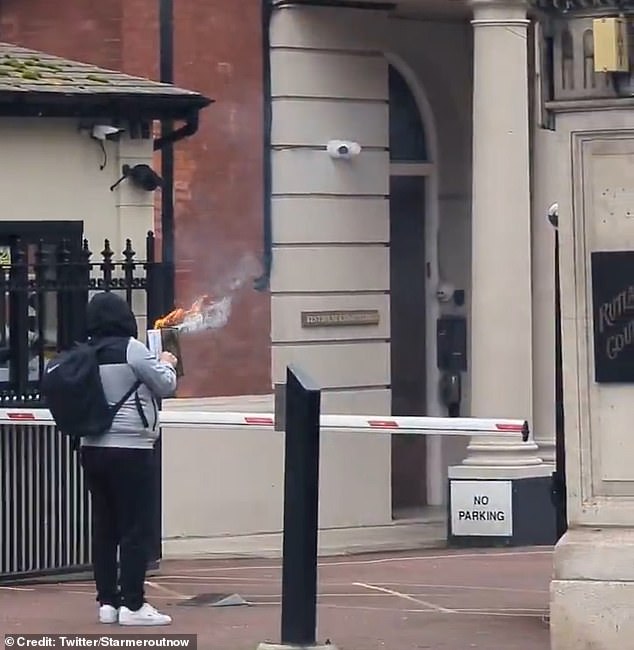A disturbing incident unfolded outside the Turkish embassy in London, capturing the attention of many as it played out in a series of shocking moments caught on video. A man, seen with a rucksack and his hood up, was holding a book on fire, reportedly the Koran, at a barrier near the embassy. This bold and provocative act quickly escalated into violence when another man attacked him with a knife. The footage, shared on social media, showed the man with the burning book being kicked violently by his attacker, who also spat at him and appeared to make slashing motions with a knife. The intensity of the situation was alarming, and emergency services, including an ambulance and police, were swiftly called to the scene. This incident, though still developing, raises questions about the motivations behind such actions and the potential consequences of provocative behavior in public spaces.
The videos posted online provide a chilling account of the events as they transpired. The initial footage shows the man standing calmly, holding up the burning book, which was identified as the Koran, a sacred text in Islam. His actions, while disturbing to many, seemed deliberate and calculated, as he chose a highly visible location—the Turkish embassy—to make his statement. The embassy, as a symbol of Turkish diplomacy and culture, may have been selected for its significance in international relations, though the exact reason behind the man’s actions remains unclear. What began as a solitary act of defiance quickly turned into a scene of violence, as another individual, seemingly angered by the burning of the book, confronted him. The attacker’s actions were brutal, involving physical assault and the threatening use of a knife, which added a layer of danger to the already volatile situation.
The presence of emergency services at the scene underscores the gravity of the incident and the need for immediate intervention. The police and ambulance teams arrived swiftly, indicating that bystanders or witnesses likely called for help as soon as the attack began. The involvement of law enforcement is crucial in such situations, not only to ensure the safety of those involved but also to prevent further escalation. Given the nature of the attack, which involved a knife and physical violence, authorities will likely investigate the incident thoroughly, examining the motivations behind the attacker’s actions and determining whether any charges should be filed. The victim’s condition is not yet known, but the fact that an ambulance was called suggests that he may have sustained injuries during the altercation.
This incident also highlights the role of social media in documenting and disseminating information about public events. The videos shared on platforms like X provide a real-time account of what transpired, allowing the public to witness the events as they unfolded. While such documentation can be invaluable for raising awareness and holding individuals accountable, it also raises ethical questions about the sharing of violent content. In this case, the footage not only captures the attack but also the moments leading up to it, including the burning of the book. These images are unsettling and may evoke strong reactions, ranging from outrage to sadness, among those who view them. Social media platforms often walk a fine line between free expression and the need to moderate content, and incidents like these underscore the importance of responsible sharing and the potential consequences of spreading distressing material.
The context of this incident adds another layer of complexity to the story. Burning religious texts, particularly the Koran, is a deeply contentious and sensitive act that can provoke strong emotions and reactions. While the right to free expression is widely recognized, it is often tempered by considerations of respect for religious beliefs and the potential for such actions to incite violence. In this case, the man’s decision to burn the Koran outside the Turkish embassy may have been intended as a form of protest or statement, but it ultimately led to a violent confrontation. The attacker’s response, while certainly not justified, reflects the intense feelings that such actions can elicit. This incident serves as a stark reminder of the delicate balance between free expression and the need to respect the beliefs and practices of others, particularly in diverse and multicultural societies like London.
As this story continues to unfold, it is important to approach it with sensitivity and understanding. The incident raises questions about the motivations of both the man who burned the book and the individual who attacked him. It also highlights the broader challenges of addressing provocative behavior in public spaces and the role of social media in shaping our perceptions of such events. While the immediate focus is on the safety of those involved and the response of law enforcement, the deeper implications of this incident cannot be overlooked. It serves as a powerful example of how actions, whether intended as statements or not, can have far-reaching consequences and spark complex and often contentious discussions. As more details emerge, it will be important to consider these dimensions and to approach the situation with empathy and an openness to understanding the perspectives of all parties involved.
